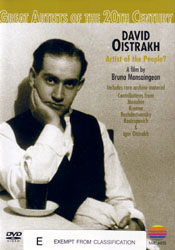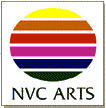David Oistrakh: Artist of the People? (1994) |
|
David Oistrakh: Artist of the People? (1994) |
|


|
| BUY IT |
| General | Extras | ||
| Category | Documentary |
Booklet Menu Animation & Audio |
|
| Rating |

|
||
| Year Of Production | 1994 | ||
| Running Time | 76:05 (Case: 75) | ||
| RSDL / Flipper | No/No | Cast & Crew | |
| Start Up | Menu | ||
| Region Coding | 2,3,4,5,6 | Directed By | Bruno Monsaingeon |
|
Studio
Distributor |
 Warner Vision |
Starring |
David Oistrakh Igor Oistrakh Yehudi Menuhin Gidon Kremer Gennadi Rozhdestvensky Mstislav Rostropovich |
| Case | Amaray-Transparent | ||
| RPI | $39.95 | Music | Various |
| Video | Audio | ||
| Pan & Scan/Full Frame | Full Frame | English Linear PCM 48/16 2.0 (1536Kb/s) | |
| Widescreen Aspect Ratio | None | ||
| 16x9 Enhancement | No | ||
| Video Format | 576i (PAL) | ||
| Original Aspect Ratio | 1.33:1 | Miscellaneous | |
| Jacket Pictures | No | ||
| Subtitles |
English Titling English French German Spanish Italian |
Smoking | No |
| Annoying Product Placement | No | ||
| Action In or After Credits | No | ||
What really set Oistrakh apart from other violinists, according to biographer Bruno Monsaingeon, was his ability to 'strike an ideal balance between the utterly predictable and the utterly abandoned, between rigour and freedom..., the epitome of purity and musical integrity'. This DVD: David Oistrakh - Artist of the People? sets out to illustrate this assertion by interviews with musical contemporaries, such as his great friend Yehudi Menuhin, conductor Gennadi Rohdestvensky and his brilliant student Gidon Kremer. There are numerous musical excerpts of Oistrakh playing from no less than 17 different composers although sadly these are all of limited duration and date back to 1936! Particularly impressive was the excerpt of his impassioned performance of Shostakovich's Violin Concerto No 2 (64:42) which was presented to him, by the composer, on his 60th birthday. As well as the musical excerpts there is fascinating footage of Monsaingeon's journey of discovery to find Oistrakh's old house and an amusing interview with an old Ukrainian couple who got quite heated on discussing who donated a fine dacha to Oistrakh !
Sadly, the stress of relentless touring, the pressure of a political system which was intolerant of second-best and a physique described by an Australian newspaper as 'pudgy' all took its toll and David Oistrakh died of a heart attack whilst on tour in Amsterdam in 1974 aged 66. Much of the documentary concerns the bitterness felt by friends and colleagues of Oistrakh against a system which took, manipulated and gave little back in return and the angst felt by Oistrakh when he was obliged to openly criticise friends and contemporaries of a different political alliance. Conspicuously lacking in the documentary was mention of his fabled two Stradivarius violins Fontana and Marsick (owned by the Soviet system of course) details of which can be found (in French) on an excellent website dedicated to the musician. He is survived by his son Igor (1931-), also a first rate violinist and an extensive repertoire of recordings.
Not surprisingly, considering the range and age of archival material, the video quality varies enormously and most video artefacts can be found in this wide ranging selection. The contemporary footage is of excellent quality and whilst some of the footage is noisy, it is all quite watchable.
Made for television, this presentation was filmed and is presented at 1.33:1 and is not 16x9 enhanced.
The present day footage has exemplary sharpness and shadow detail. Older film stock footage has the characteristic limited contrast range but on the whole is sharply focussed. There was no low level noise of note.
Most of the archival footage is in black and white, but the few colour inserts have good quality, albeit with a slightly aged and washed-out chroma range without noise.
Mild aliasing is evident throughout but is not objectionable most of the time. There is a severe combing artefact at 5:05 and 33:20. Not surprisingly, film artefacts in the form of white and black flecks, scratches and dirt are in plentiful supply but the film quality is really quite good and the 1936 excerpt of Debussy's La Plus que Lente was particularly impressive.
Subtitles are available in English, French, German, Spanish and Italian which is just as well unless you are a native Russian and Ukrainian speaker, as the majority of the interviews are conducted in the speaker's native tongue.
The disc is a single layered DVD-5 and therefore there is no layer change.
| Sharpness | |
| Shadow Detail | |
| Colour | |
| Grain/Pixelization | |
| Film-To-Video Artefacts | |
| Film Artefacts | |
| Overall |
Much of the video quality comments applies equally to the audio, namely that the archival footage falls short of perfection on account of its age and technical limitations of the time, but despite obvious artefacts is quite pleasurable to listen to.
There is one audio track on this DVD in LPCM 48/16 stereo encoded at 1536 kbps.
Dialogue is clear and easily decipherable.
There are no perceptible sync problems.
The music is generally thin sounding and flat. Flutter is much less noticeable in violin music than say piano due to intended player vibrato effect. There was unpleasant distortion at 4:20 but this was rare throughout the DVD. The background hiss, crackle and occasional pop tended to augment the historic feel of the pieces and I didn't find it intrusive or objectionable.
Your surrounds and subwoofer can rest undisturbed throughout this recording.
| Dialogue | |
| Audio Sync | |
| Clicks/Pops/Dropouts | |
| Surround Channel Use | |
| Subwoofer | |
| Overall |
NOTE: To view non-R4 releases, your equipment needs to be multi-zone compatible and usually also NTSC compatible.
The video quality is limited by archival material, but good considering and up to the job asked of it.
The audio quality is likewise limited by age but adequate.
The booklet is excellent as are the subtitles. Some extended playing footage, as an extra, would have been great but probably not feasible in this low budget TV documentary to DVD transfer.
| Video | |
| Audio | |
| Extras | |
| Plot | |
| Overall |
| Review Equipment | |
| DVD | EAD 8000 Pro, using Component output |
| Display | NEC MP3. Calibrated with Video Essentials/Ultimate DVD Platinum. |
| Audio Decoder | Sony STR-DB1080. Calibrated with Video Essentials. |
| Amplification | Theta Digital Intrepid |
| Speakers | ML Aeon front. B&W LRC6 Centre. ML Script rear. REL Strata III SW. |